Papers by Christopher K Anand
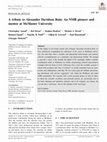
Concepts in Magnetic Resonance Part A, Nov 1, 2016
In this tribute to our friend, mentor and colleague Alexander Davidson Bain we have collectively ... more In this tribute to our friend, mentor and colleague Alexander Davidson Bain we have collectively recapitulated the milestones of his career at McMaster university. We start from Alex's scientific and educational achievements and continue with his accomplishments as a community and infrastructure builder. We attempt to provide a sense of the breadth and depth of his seemingly endless scientific contributions while at McMaster by briefly summarizing selected representative examples from his body of work. Following Alex's lead, the scientific account is mixed with anecdotes and "bits of wisdom" we fondly remember from our interactions and collaborations with him. We also touch upon his brilliant and nurturing educational style and his "aggregator" role within the McMaster and wider NMR communities. We conclude with a more personal picture of Alex D. Bain, in which his scientific excellence and profound intellect are inextricably tied to his kind, nurturing and optimistic character and to his uniquely wry humor. He was not just a "good guy," he was the epitome of the "good guy."
Conference of the Centre for Advanced Studies on Collaborative Research, 2018

Chapman & Hall/CRC eBooks, 2000
HARMONIC MORPHISMS The Beginings of Harmonic Morphisms, B. Fuglede Harmonic Morphisms via Deforma... more HARMONIC MORPHISMS The Beginings of Harmonic Morphisms, B. Fuglede Harmonic Morphisms via Deformation of Metrics for Horizontally Conformal Maps, X. Mo On Submersive Harmonic Morphisms, R. Pantilie On the Stability of Harmonic Morphisms, S. Montaldo Applications of the Bachner Technique to Harmonic Morphisms between Simply-Connected Space Forms, M.T. Mustafa On the Construction of Harmonic Morphisms from Euclidean Spaces, J.C. Wood Harmonic Polynomial Morphisms and Milnor Fibrations, P. Baird and Y.-L. Ou Harmonic Maps and Morphisms on Metric f-Manifolds with Paralellizable Kernel, S. Ianus and A.M. Pastore Quasi-Harmonic Maps between Almost Symplectic Manifolds, P. Baird and C.L. Bejan A Discrete Analogue of Harmonic Morphisms, H. Urakawa Harmonic Morphisms of Metric Graphs, C.K. Anand Time Dependent Conservation Laws and Symmetries for Classical Mechanics and Heat Equations, A. Brandao and T. Kolsrud HARMONIC MAPS: GENERAL THEORY, MAPS OF SURFACES, AND RELATED VARIATIONAL PROBLEMS Harmonic Maps and Morphisms from Spheres and Deformed Spheres,Y.-X. Dong S1-Valued Harmonic Maps with High Topological Degree, E. Sandier and M. Soret Harmonic Maps to Non-Locally Compact Spaces, R. Shoen Harmonic Extensions of Quasi-Conformal Maps to Hyperbolic Space, R. Hardt and M. Wolf Harmonic Mappings from Riemann Surfaces, J.-Y. Chen On the Normal Bundle of Minimal Surfaces in Almost Kahler 4-Manifolds, M. Ville Harmonic Sequences of Harmonic 2-Surfaces in Grassmann Manifolds, X. Mo and C.J.C. Negreiros An Example of a Nontrivial Bubble Tree in the Harmonic Map Heat Flow, P. Topping Gauge-Theoretic Equations for Symmetric Spaces and Certain Minimal Submanifolds in Moduli Spaces, Y. Ohnita Moduli Spaces of Solutions to the Gauge Theoretic Equations for Harmonic Maps, M. Mukai On the Set of Minimizers of the Ginzburg-Landau Functional in Dimension 2, F. Pacard and T. Riviere CONSTANT MEAN CURVATURE SURFACES Surfaces in Minkowski 3-Space and Harmonic Maps, J.-I. Inoguchi The Splitting and Deformations of the Gauss Map of Compact C.M.C. Surfaces, R. Miyaoka Representation Formulas for Surfaces in H3(-c2) and Harmonic Maps Arising from CMC Surfaces, R. Aiyama and K. Akutagawa A Weierstrass Representation for Willmore Surfaces, F. Helein Effect of Topology on H-Surfaces, Y. Ge
2022 IEEE International Conference on Data Science and Information System (ICDSIS), Jul 29, 2022
Conference of the Centre for Advanced Studies on Collaborative Research, 2018
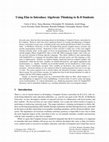
In recent years, there has been increasing interest in developing a Computer Science curriculum f... more In recent years, there has been increasing interest in developing a Computer Science curriculum for K-8 students. However, there have been significant barriers to creating and deploying a Computer Science curriculum in many areas, including teacher time and the prioritization of other 21st-century skills. At McMaster University, we have developed both general computer literacy activities and specific programming activities. Integration of these activities is made easy as they each support existing curricular goals. In this paper, we focus on programming in the functional language Elm and the graphics library GraphicSVG. Elm is in the ML (Meta Language) family, with a lean syntax and easy inclusion of Domain Specific Languages. This allows children to start experimenting with GraphicSVG as a language for describing shape, and pick up the core Elm language as they grow in sophistication. Teachers see children making connections between computer graphics and mathematics within the first hour. Graphics are defined declaratively, and support aggregation and transformation, i.e., Algebra. Variables are not needed initially, but are introduced as a time-saving feature, which is immediately accepted. Since variables are declarative, they match students' expectations. Advanced students are also exposed to State by making programs that react to user taps or clicks. The syntax required to do so closely follows the theoretical concepts, making it easy for them to grasp. For each of these concepts, we explain how they fit into the presentations we make to students, like the 5200 children taught in 2016. Finally, we describe ongoing work on a touch-based Elm editor for iPad, which features (1) type highlighting (as opposed to syntax highlighting), (2) preservation of correct syntax and typing across transformations, (3) context information (e.g. displaying parameter names for GraphicSVG functions), and (4) immediate feedback (e.g. restarting animations after every program change).
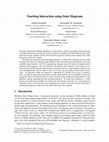
Electronic Proceedings in Theoretical Computer Science
To make computational thinking appealing to young learners, initial programming instruction looks... more To make computational thinking appealing to young learners, initial programming instruction looks very different now than a decade ago, with increasing use of graphics and robots both real and virtual. After the first steps, children want to create interactive programs, and they need a model for this. State diagrams provide such a model. This paper documents the design and implementation of a Model-Driven Engineering tool called SD Draw, that allows even primary-aged children to draw and understand state diagrams, and create modifiable app templates in the Elm programming language using the model-view-update pattern standard in Elm programs. We have tested this with grade 4 and 5 students. In our initial test, we discovered that children quickly understand the motivation and use of state diagrams using this tool, and will independently discover abstract states even if they are only taught to model using concrete states. To determine whether this approach is appropriate for children of this age we wanted to know: do children understand state diagrams, do they understand the role of reachability, and are they engaged by them? We found that they are able to translate between different representations of state diagrams, strongly indicating that they do understand them. We found with confidence p = 0.001 that they do understand reachability by refuting the null hypothesis that they are creating diagrams randomly. And we found that they were engaged by the concept, with many students continuing to develop their diagrams on their own time after school and on the weekend.

In this paper, we examine the implementation and acceleration of the Poly1305 authentication algo... more In this paper, we examine the implementation and acceleration of the Poly1305 authentication algorithm on the recently announced IBM z14 computer. Two approaches are undertaken to improve performance of this important cryptographic algorithm. First, we restructure the algorithm to take advantage of a new instruction, VMSL, which employs floating-point hardware to perform high-speed high-throughput multiplications on integer limbs (big-integer digits) of large integers. With VMSL, we are able to eliminate multiplication as the dominant operation in Poly1305. Second, we apply Coconut, an extensible domain-specific language (DSL) embedded in Haskell, to generate a better schedule for parts of the algorithm that are performance bottlenecks. This combined approach has implications beyond Poly1305, as the same techniques can be applied to other cryptographic algorithms, such as elliptic curve digital signature algorithm (ECDSA) used in HyperLedger Blockchain.
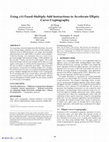
Due to growing commercial applications like Blockchain, the performance of large-integer arithmet... more Due to growing commercial applications like Blockchain, the performance of large-integer arithmetic is the focus of both academic and industrial research. IBM introduced a new integer fused multiplyadd instruction in z14, called VMSL, to accelerate such workloads.1 Unlike their floatingoint counterparts, there are a variety of integer fused multiply-add instruction designs. VMSL multiplies two pairs of radix 256 inputs, sums the two results together with an additional 128-bit input, and stores the resulting 128-bit value in a vector register. In this paper, we will describe the unique features of VMSL, the ways in which it is inherently more efficie than alternativ e specifications in particular by enabling multiple carry strategies. We will then look at the issues we encountered implementing Montgomery Modular Multiplication for Elliptic Curve Cryptography on z14, including radix choice, mixed radices, instruction selection to trade instruction count for latency, and VMSL-specifi o...
Electronic Proceedings in Theoretical Computer Science, 2018
CRC Press eBooks, Jul 18, 2013
We show that a twistor construction of Hitchin and Ward can be adapted to study unitons (harmonic... more We show that a twistor construction of Hitchin and Ward can be adapted to study unitons (harmonic spheres in a unitary group). Specifically, we show that unitons are equivalent to holomorphic bundles with extra structure over a rational ruled surface with energy given by Chern class. This equivalence allows us to confirm the conjecture of Wood that unitons are rational. We also construct an example of a two uniton in U(3) using this construction.
Proceedings of the 2010 Conference of the Center for Advanced Studies on Collaborative Research - CASCON '10, 2010
Computations involving sparse and structured matrices arise frequently in problems in operations ... more Computations involving sparse and structured matrices arise frequently in problems in operations research, science and engineering. Exploiting this structure has been a major contributor to the efficient application of past and current computing platforms, and will continue to play an important role for next-generation systems.



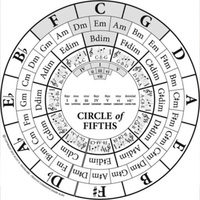

Uploads
Papers by Christopher K Anand